• Non-Stick
12 Ways To Not Ruin Your Nonstick Pans

Reviewed by Trinity Anderson
Last Updated January 2024
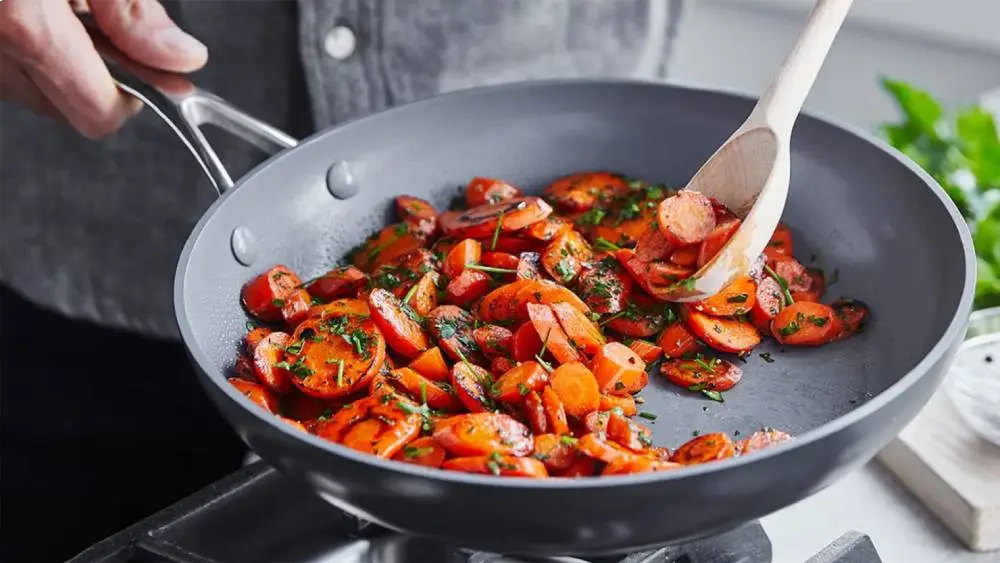
When I sat down to write this article, I was convinced of one thing:
Certainly, I am not the sole individual who must replace their Teflon type nonstick pan every 2 – 3 years, occasionally even sooner, because it is no longer nonstick?
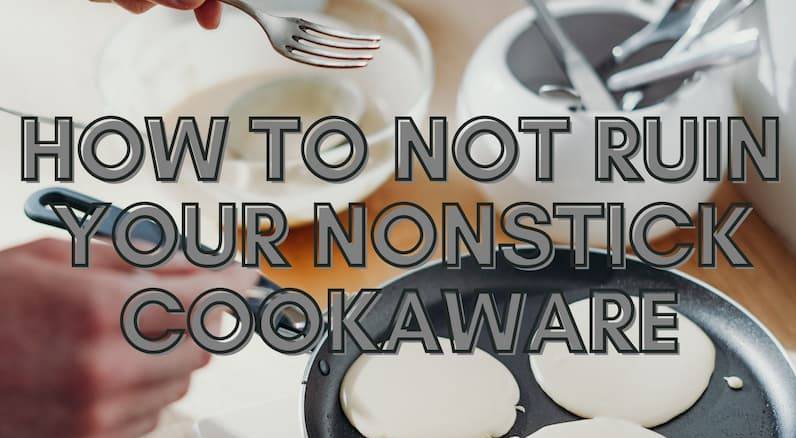
Despite all the buzz surrounding consumers shifting away from traditional ptfe (teflon) nonstick pans due to health or environmental concerns (which I will not delve into in this article), the reality remains that the nonstick market in the USA is substantial, a staggering $1.47 billion as of 2019, and projected to continue growing.
This implies that millions of us are utilizing nonstick pans and encountering the challenge of ruined nonstick pans every few years.
While there is much discussion about what to consider when purchasing a pan, there is insufficient emphasis on what to do after you have bought it in order to maintain its nonstick properties for a longer period.
Now, let us be clear about one thing – all nonstick pans have a limited lifespan and will eventually begin to stick. Therefore, unlike, for instance, a stainless steel pan that can last a lifetime, a nonstick pan will need to be replaced at some point.
To comprehend how to prolong the lifespan of a nonstick pan, we must first understand...
Why do nonstick pans start to stick?
Most conventional nonstick coatings are composed of PTFE or Teflon, which is a type of plastic compound.
With usage and the passage of time, this plastic gradually breaks down. According to information from Wikipedia, PTFE (also known as Teflon) begins to deteriorate once the cookware reaches approximately 260 °C (500 °F), and decomposes at temperatures above 350 °C (662 °F).
In essence, it evaporates and disperses as fumes.
This holds true even for "reinforced" nonstick coatings. You may have come across nonstick pans that are reinforced with titanium, granite, or even diamonds.
Indeed, these pans tend to be more resilient and long-lasting due to the added reinforcements. However, the fundamental properties of PTFE remain unchanged. Over time, it will disintegrate and lose its nonstick functionality.
This brings us to the primary focus of this article. While there are numerous tips available on how to use a nonstick pan effectively, there is little guidance on how to avoid using it in a way that prematurely damages it. But fret not, the Cookware Advisor has compiled a comprehensive list of:
12 ways to not ruin your nonstick pan
1. Always use some oil or fat and rub it on the nonstick pan before heating it.
The issue at hand is that many individuals mistakenly believe that nonstick cooking requires no fat whatsoever, whether due to a fear of fats or for some other reason.
However, even with nonstick cookware, I firmly believe that a small amount of fat is necessary to act as a lubricant and to optimize the performance of the nonstick surface.
Now, I'm not suggesting drenching the pan in oil or plopping a large chunk of butter onto it, as that would result in the fat being absorbed by the food rather than sticking to the pan.
Instead, I recommend lightly coating the nonstick pan with a thin layer of oil or butter, just enough to cover its surface. Approximately a teaspoon should suffice. Here's my approach: I take a small silicone brush, dip it in some oil, and evenly spread it across the cold pan before heating it.
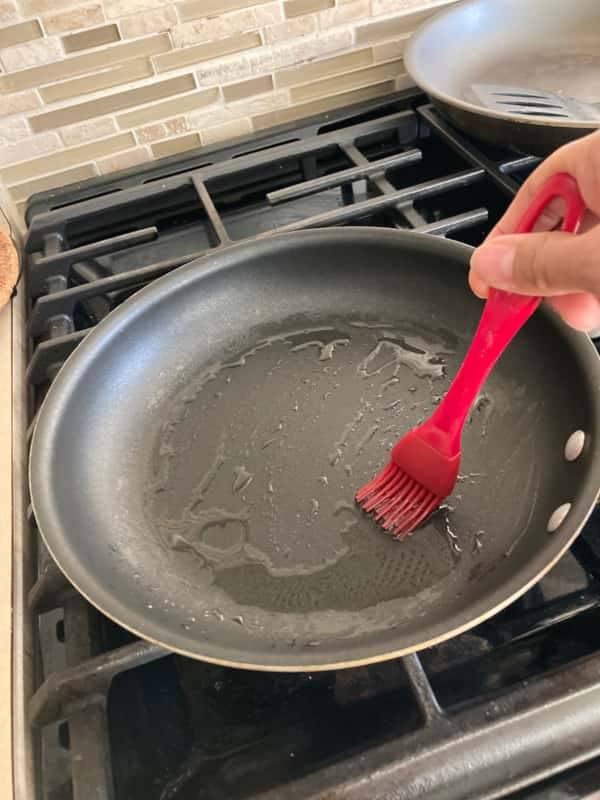
2. Handwash, don’t dishwash.
Numerous nonstick cookware brands assert their compatibility with dishwashers. Similarly, some of them even promote the usage of metallic mixers and knives directly in the pan, which is strongly discouraged.
However, it is important to recognize these claims as mere marketing tactics. In reality, the intense heat and abrasive detergents employed in dishwashers can deteriorate the nonstick coating and reduce the longevity of your cookware.
3. Don’t preheat an empty pan.
To begin with, there is no necessity to preheat a nonstick pan, which may appear contradictory as we typically preheat a stainless steel pan before adding food. However, different surfaces require different approaches.
Furthermore, it is important to note that Teflon type coatings begin to deteriorate when the pan reaches a temperature of 500°F. Have you ever wondered how long it takes for a pan to reach such a temperature? Here is the answer:
The Good Housekeeping Institute conducted a test to determine the time it takes for a nonstick pan to overheat. Surprisingly, an empty pan took less than 2 minutes to heat up to over 500°F. And if the pan contains oil, it took a staggering 2.5 minutes to reach 514°F.
4. No high heat.
It is crucial to utilize nonstick cookware at moderate and slightly low temperatures. The reason behind this is that when exposed to high heat (500F and above), the coating begins to emit fumes and deteriorate.
These fumes, commonly referred to as 'Teflon' fumes, can be extremely harmful to humans and pose a lethal threat to pet birds.
5. Don’t use metal utensils.
Many nonstick pans advertise themselves as being safe for use with metal utensils because of their fortified coating. However, I strongly advise against following these claims. It is best to stick with using wooden, plastic, or silicone utensils.
In my experience, even with the use of these utensils, nonstick pans will inevitably develop fine lines and scratches. This is simply the reality of any nonstick coating.
Regarding those advertisements that showcase metal beaters or knives being used directly in a nonstick pan, it is important to recognize them as marketing gimmicks. No nonstick coating can withstand such abuse.
6. Don’t use cooking spray.
Cooking sprays are typically composed of cooking oil, such as canola, olive, or corn oil, along with soy lecithin as an emulsifier to prevent separation. Additionally, they contain an anti-foaming agent and a propellant, which aids in the spray mechanism. However, over time, the lecithin and other non-burning additives can accumulate as a sticky residue, compromising the nonstick properties of the pan. Moreover, this residue is not easily washed off and requires additional steps for removal.
A simpler alternative would be to use the aforementioned method of brushing the pan with oil or butter. By avoiding the use of cooking sprays with additives, there will be no residue left behind, ensuring the preservation of the pan's nonstick qualities.
7. If it overheats and fumes, lower or remove heat
Throughout the lifespan of your nonstick pan, it is almost certain that at some point, the pan will accidentally overheat. This can be identified by the release of fumes from the pan. To put it simply, this indicates that the plastic nonstick coating is deteriorating and dispersing into the air.
In such a situation, it is advisable to promptly reduce the heat or, even better, remove the pan from the heat source until it has adequately cooled down.
8. Don’t store food in it
Prolonged exposure to food, especially acidic food like tomatoes, can accelerate the deterioration of a nonstick coating. It is advisable to resist the urge of leaving food in the pan after cooking or, even worse, storing it in the refrigerator while still in the pan.
9. Don’t stack without a protective layer
To prevent scratching and damaging the coating, it is advisable to avoid stacking pans on top of each other. Consider using pan protectors or a simple solution like placing a sheet of kitchen roll between the pans.
10. Don’t expect it to do what it is not meant to do
When it comes to cooking, certain techniques require a specific type of cookware. For instance, charring a piece of meat or searing it to create a flavorful base for deglazing into a gravy. These techniques rely on the reaction between a hot metallic surface and the proteins in the meat, which cannot be achieved with a nonstick pan. Attempting to do so may lead to overheating your nonstick pan.
On the other hand, nonstick cookware is perfect for more delicate cooking tasks such as making eggs or crepes. For high heat cooking, it is best to rely on your stainless steel pan.
11. Don’t clean with an abrasive pad
It may be tempting at times to utilize the coarse side of a scrubbing sponge, but doing so can potentially harm and create scratches on the nonstick coating. Instead, opt for a gentle scrubby or washcloth. Avoid any abrasive cleaning tools.
12. Don’t use nonstick cookware in an oven
A multitude of nonstick brands that come with metallic pan handles also promote their oven-safe feature (up to a specific temperature). However, there are numerous superior alternatives for oven usage, such as cast iron, stainless steel, and even ceramic.
When cooking in the oven, a pan is subjected to intense and consistent heat. It is important to remember that traditional nonstick coatings are essentially made of plastic. Exposure to the oven will inevitably accelerate the deterioration of this plastic material.
Let's assume that you have taken all the necessary precautions and successfully extended the lifespan of your favorite nonstick pan for a few years. However, you may notice that the pan is no longer performing as effectively as it used to, and you may be wondering if you have indeed caused damage to your pan.
How do you tell if your nonstick pan is ruined?
There are various signs that indicate your nonstick pan is no longer in good condition:
1. Food starts sticking to the pan, indicating that the nonstick coating is wearing off.
2. The coating is heavily scratched, causing food to stick instead of releasing easily. It is important to note that minor scratches are normal, even when using wooden or plastic utensils.
3. The coating is chipping off, resulting in flakes of coating appearing in your food.
4. You can see the underlying metal where the coating is worn off or scratched. This means that the nonstick properties are no longer effective, and food will stick to the pan. If the exposed metal is plain aluminum, there may also be concerns about metal leaching into your food.
5. The nonstick coating becomes discolored or stained.

For instance, in the attached photo of one of my favorite cookware brands, you can observe that after nearly 4 years of heavy usage, food is starting to stick to the pan, requiring additional seasoning for better food release. Furthermore, the coating is heavily scratched, despite consistently using wooden and silicone utensils, and the color has faded from a dark graphite to a dull gray.
Considering these factors, it is evident that it is time for me to replace this pan.
Should you replace a nonstick pan that is starting to stick?
In many instances, by incorporating a slightly larger amount of oil or butter during the cooking process, you can extend the lifespan of a pan by several additional months (or even years). This technique prevents food from adhering to the pan's surface, allowing it to maintain its functionality, with the exception of more adhesive foods such as eggs.
Should you replace a nonstick pan that is badly scratched?
Certainly, I would agree. A severely scratched pan indicates that the nonstick coating has been compromised, resulting in a diminished ability to release food as desired.
Is it safe to continue using a scratched or flaking nonstick pan?
This question can be divided into two parts. Firstly, if the coating on a pan chips or flakes off and you accidentally ingest it, is there a risk? Rest assured, there is not much risk if you accidentally ingest a piece of Teflon or PTFE coating.
Teflon is an inert plastic that will simply pass through your system. In fact, Teflon is even used in joint replacements due to its non-reactive nature. Secondly, if the coating on a pan is so badly scratched or worn off that the underlying metal is exposed, is it safe to use? According to my research, whether the underlying pan is made of aluminum or stainless steel, no significant amount of metal leaches into the food when the metal is exposed.
In conclusion, it is not unsafe to use a scratched or flaking nonstick pan. However, it is advisable to replace it at that point because it will no longer function as a nonstick pan.
How long should a nonstick pan last?
It is important to note that nonstick pans have a significantly shorter lifespan compared to stainless steel or cast iron pans, which can last indefinitely.
In the case of a light and reasonably priced nonstick pan, you can expect it to last for approximately 1-2 years.
However, if you invest in a high-quality pan with a heavy gauge metal base and multiple layers of reinforced non-stick coating, you can expect it to last for around 3 years.
It is worth mentioning that your personal experience may vary and could fall within or exceed these estimated timeframes. The longevity of your nonstick pan depends on factors such as frequency of use, usage patterns, and proper care and maintenance.
Here are Cookware Advisor suggestions for the best nonstick pans:
1. Made in Cookware Nonstick Fry Pans
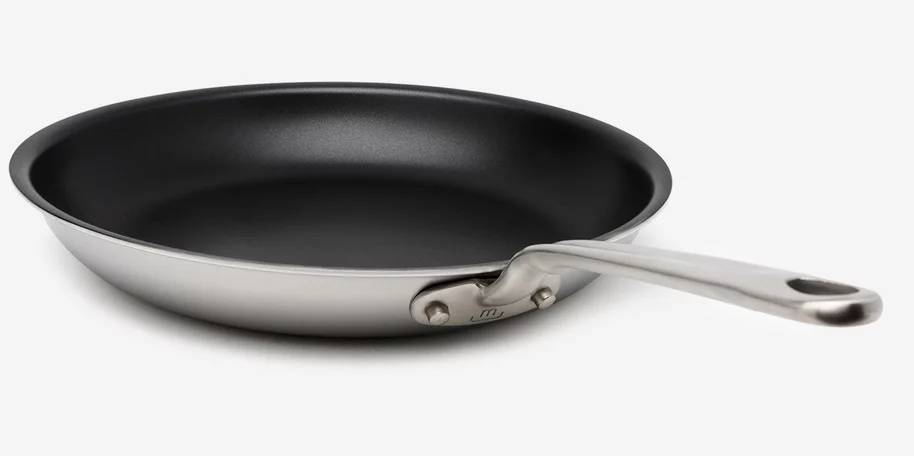
2. Scanpan Professional Nonstick Fry pan
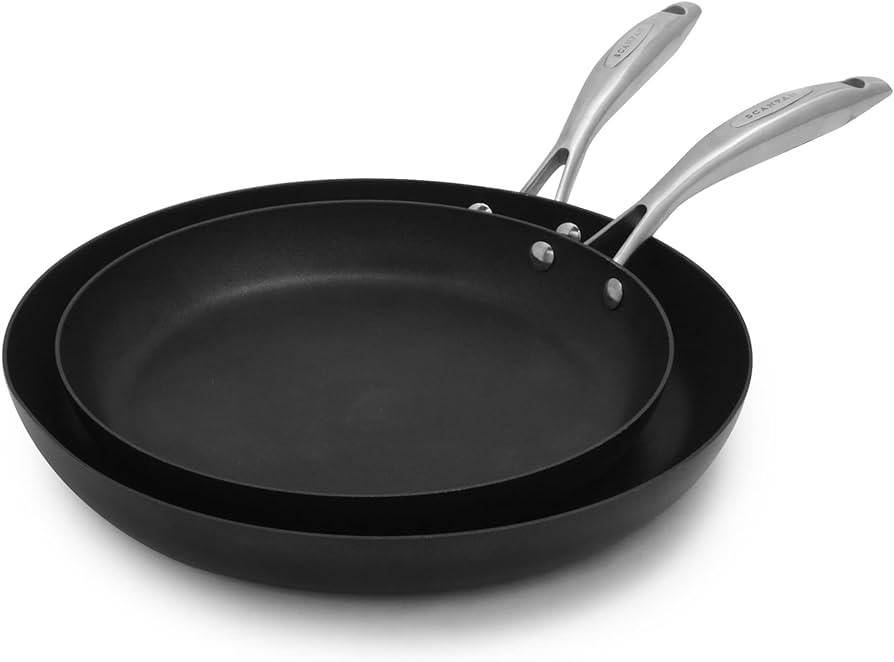
3. All-Clad Hard Anodized Nonstick Fry pan
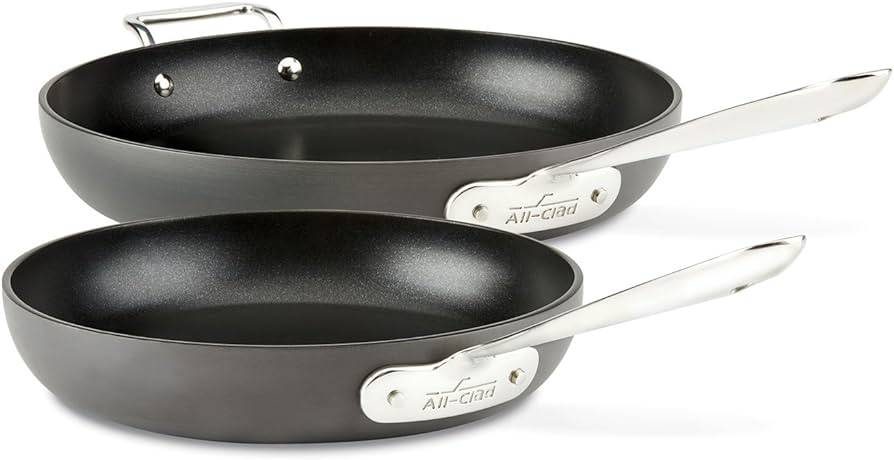
Can nonstick pans be recoated?
This question is frequently asked and it certainly piques my interest. However, without the assistance of professional services, the answer remains the same: no.
This task cannot be accomplished by an ordinary home cook as it is not a do-it-yourself process. Once the nonstick coating is damaged, it is advisable to invest in a new pan.
How do you deep clean a nonstick pan?
Occasionally, a nonstick pan may develop a stubborn residue that cannot be removed with a regular gentle scrub using soap. In such cases, it is necessary to perform a thorough cleaning. Heat a solution of 1/2 cup vinegar and 1 cup water in the pan. Allow it to simmer for a few minutes, then let it cool down. Afterward, proceed to wash your pan as you normally would.